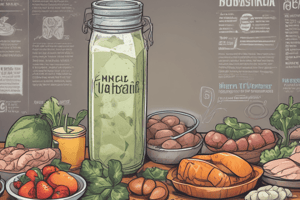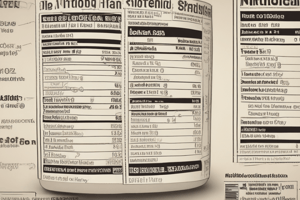Podcast
Questions and Answers
¿Qué estructura describe el arreglo de múltiples cadenas de polipéptidos en una única proteína funcional?
¿Qué estructura describe el arreglo de múltiples cadenas de polipéptidos en una única proteína funcional?
¿Qué proceso se produce cuando las proteínas se exponen a calor, ácido, altas concentraciones de sal, alcohol o agitación mecánica?
¿Qué proceso se produce cuando las proteínas se exponen a calor, ácido, altas concentraciones de sal, alcohol o agitación mecánica?
¿Qué función tienen las proteínas en los sistemas alimentarios según el texto?
¿Qué función tienen las proteínas en los sistemas alimentarios según el texto?
¿Cómo influye la secuencia de aminoácidos en la estructura de las proteínas?
¿Cómo influye la secuencia de aminoácidos en la estructura de las proteínas?
Signup and view all the answers
¿Qué fuentes pueden proporcionar proteínas según el texto?
¿Qué fuentes pueden proporcionar proteínas según el texto?
Signup and view all the answers
¿Qué ocurre durante la desnaturalización de las proteínas?
¿Qué ocurre durante la desnaturalización de las proteínas?
Signup and view all the answers
¿En qué nivel de estructura de proteínas se refiere a la disposición lineal de aminoácidos en la cadena de polipéptidos?
¿En qué nivel de estructura de proteínas se refiere a la disposición lineal de aminoácidos en la cadena de polipéptidos?
Signup and view all the answers
¿Qué nivel de estructura de proteínas se refiere a la conformación tridimensional de una proteína que surge del plegamiento de la cadena polipéptida?
¿Qué nivel de estructura de proteínas se refiere a la conformación tridimensional de una proteína que surge del plegamiento de la cadena polipéptida?
Signup and view all the answers
¿Qué estructuras específicas, como las alpha-hélices o las láminas beta, son estabilizadas por enlaces de hidrógeno en las proteínas?
¿Qué estructuras específicas, como las alpha-hélices o las láminas beta, son estabilizadas por enlaces de hidrógeno en las proteínas?
Signup and view all the answers
¿Cuál es el proceso por el cual una proteína pierde su estructura tridimensional y, por lo tanto, su función biológica debido a factores como el calor o el pH extremo?
¿Cuál es el proceso por el cual una proteína pierde su estructura tridimensional y, por lo tanto, su función biológica debido a factores como el calor o el pH extremo?
Signup and view all the answers
¿Cuál es el nivel de estructura de proteínas que se refiere a la disposición tridimensional formada por la interacción de múltiples cadenas polipeptídicas?
¿Cuál es el nivel de estructura de proteínas que se refiere a la disposición tridimensional formada por la interacción de múltiples cadenas polipeptídicas?
Signup and view all the answers
¿Qué función principal tienen las proteínas en los sistemas alimentarios según la ciencia de los alimentos?
¿Qué función principal tienen las proteínas en los sistemas alimentarios según la ciencia de los alimentos?
Signup and view all the answers
Study Notes
Proteins in Food Science: Structure, Denaturation, Functionality, and Sources
Proteins are essential macromolecules that play a crucial role in various biological processes and food systems. In food science, proteins contribute to the structure, texture, and physiological properties of food products. This article will cover the structure of proteins, the process of protein denaturation, the functionality of proteins, and their sources.
Protein Structure
Proteins are complex molecules composed of amino acids linked by peptide bonds. These amino acids can be arranged in different sequences, leading to a vast variety of proteins. The structure of proteins can be described at four levels: primary, secondary, tertiary, and quaternary.
Primary Structure
The primary structure refers to the linear arrangement of amino acids in the polypeptide chain. The sequence of amino acids determines the three-dimensional structure of the protein and its function.
Secondary Structure
Secondary structure is the arrangement of amino acids in specific patterns, such as alpha-helices or beta-pleated sheets, which are stabilized by hydrogen bonds. These structures contribute to the stability and function of the protein.
Tertiary Structure
Tertiary structure is the three-dimensional conformation of a protein that arises from the folding of the polypeptide chain. This structure is influenced by the amino acid sequence, as well as by the presence of cofactors and other noncovalent interactions.
Quaternary Structure
Quaternary structure describes the arrangement of multiple polypeptide chains into a single functional protein. This structure can be seen in proteins like hemoglobin, which is composed of four polypeptide chains.
Protein Denaturation
Denaturation occurs when proteins are exposed to conditions that disrupt their natural structure. This process can be triggered by heat, acid, high salt concentrations, alcohol, or mechanical agitation. Denaturation results in the loss of the protein's functional properties, as its complex three-dimensional structure is disrupted. For example, when cooking an egg, the heat causes the proteins to denature, resulting in a solid mass.
Protein Functionality
Proteins have various functions in food systems, such as providing structure and texture, enabling water retention, and contributing to the color and flavor of food products. For instance, milk proteins called caseins coagulate, thickening yogurt. Egg proteins aggregate during baking, providing structure to cakes.
Protein Sources
Proteins can be derived from various sources, including animal products (meat, dairy, eggs), plant-based sources (legumes, nuts, soy), and microorganisms (yeast, bacteria). These sources can be used to fortify food products with additional protein content, enhancing their nutritional value.
In conclusion, proteins play a vital role in food science, contributing to the structure, texture, and functionality of various food products. Understanding the structure and behavior of proteins is essential for developing and improving food products that meet the nutritional demands of consumers.
Studying That Suits You
Use AI to generate personalized quizzes and flashcards to suit your learning preferences.
Description
Explore the essential role of proteins in food science, covering their structure at different levels, denaturation process, functionality in food systems, and diverse sources. Learn how proteins contribute to the structure, texture, and nutritional value of food products.




